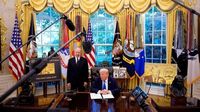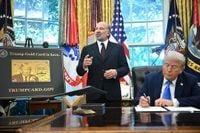On Friday, September 19, 2025, President Donald Trump unveiled a sweeping overhaul of America’s immigration system, rolling out the much-hyped “Trump Gold Card” visa program alongside a dramatic increase in fees for H-1B visa applicants. The dual executive orders, signed in the Oval Office with Commerce Secretary Howard Lutnick at his side, signal a sharp pivot in U.S. policy toward both the world’s wealthy and the global pool of skilled workers. The moves, Trump asserts, will generate billions for the federal treasury and protect American jobs—but they’ve sparked immediate controversy, legal uncertainty, and concern from businesses, foreign governments, and immigration advocates alike.
The centerpiece of Trump’s announcement is the Trump Gold Card, a new visa category that grants permanent U.S. residency—and a pathway to citizenship—to foreign nationals willing to make a $1 million “gift” to the Department of Commerce. For corporations, the price tag is even steeper: $2 million per sponsored employee, with the added perk that the card is transferable among workers for a fee. According to the program’s official website, a “Platinum Card” will soon follow, costing $5 million and offering holders up to 270 days in the U.S. each year without being taxed on non-U.S. income. The Platinum Card, however, will require congressional approval before it’s implemented.
“They’re going to spend a lot of money to come in,” Trump told reporters, his signature emblazoned on the glossy new cards. “It’s going to raise billions of dollars, billions and billions of dollars, which is going to go to reduce taxes, pay off debt and for other good things,” Bloomberg reported. Commerce Secretary Lutnick echoed the optimism, predicting the program could generate $1 trillion and claiming some 250,000 wealthy individuals had already expressed interest, according to The Times of India.
The new cards will replace existing employment-based visa categories, notably the EB-1 and EB-5 programs, which previously allowed foreigners with extraordinary abilities or those making targeted investments to become lawful permanent residents. Fewer than 10,000 such visas were issued each year under the old system, but Trump’s team anticipates a windfall from the new approach. Lutnick explained that after a brief implementation phase, “other visa green card categories are likely to be suspended, and this will be the model that people can come in to the country,” as reported by Bloomberg.
Revenue from the Gold and Platinum Card programs will be deposited into a dedicated Treasury fund to promote commerce and American industry, according to the executive order. Applicants must register through a federal website and undergo what Lutnick described as “a much more rigorous vetting than has ever been done before,” with a $15,000 processing fee for the Gold Card. The Department of Homeland Security will conduct background checks to weed out those deemed undesirable, including members of criminal organizations or individuals with ties to terrorism, Trump aides assured the press.
Yet the legality of the entire initiative is already under scrutiny. Critics argue that the power to create new visa categories rests with Congress, not the executive branch. “The administration’s use of Section 212(f) of the Immigration and Nationality Act to block entry of visa applicants who have not paid the fee may face legal challenges,” noted immigration attorney Kathleen Campbell Walker in Hindustan Times. Former USCIS official Doug Rand was blunt, calling the Gold Card initiative “ludicrously lawless,” and predicting it could unravel in court.
While the administration frames the Gold Card as a win-win—attracting capital and creating jobs while raising revenue—opponents warn it commodifies American residency and undermines the principles of merit-based immigration. “Critics say the program commodifies residency and may face legal challenges,” Hindustan Times reported, capturing the unease among immigration lawyers and advocacy groups.
The announcement comes as the Trump administration simultaneously escalates its crackdown on the H-1B visa program, a mainstay for U.S. tech firms and skilled foreign workers. Effective September 21, 2025, a new $100,000 fee applies to all new H-1B visa applicants—up from just $215 previously. The fee, described by White House press secretary Karoline Leavitt as “a one-time payment,” targets companies in technology, engineering, and science that rely on foreign talent to fill high-skill roles. The White House clarified that the fee does not affect current H-1B holders or renewals, but only new applicants in the upcoming 2026 lottery.
Commerce Secretary Lutnick defended the fee as a measure to protect American jobs and encourage companies to hire domestically. “If you’re going to train somebody, you’re going to train one of the recent graduates from one of the great universities across our land,” he said, as quoted by Hindustan Times. Trump added, “We need great workers. And this pretty much ensures that this is what’s going to happen,” according to OPB. Lutnick was more direct: “Either the person is very valuable to the company and America, or they’re going to depart and the company is going to hire an American.”
The abrupt rollout of the new H-1B fee has sown confusion and anxiety among visa holders and their employers. Tech giants like Amazon, Microsoft, and JPMorgan advised employees on H-1B visas to remain in the U.S. until further guidance is issued. The U.S. Chamber of Commerce said it is working with the administration to understand the implications for employers and employees. In India, which accounts for more than 70 percent of H-1B recipients, officials expressed concern about the humanitarian impact, especially for families separated by the fee change. “We are studying the order and urge U.S. authorities to address potential disruptions,” said Foreign Ministry spokesperson Randhir Jaiswal.
The H-1B program remains capped at 85,000 new visas annually, with companies like Amazon receiving over 10,000 visas in 2025, according to Hindustan Times. The new fee is expected to dramatically reduce the number of applications, a move praised by advocacy groups like U.S. Tech Workers as “the next best thing” to abolishing the visa entirely. Critics of the H-1B system argue it depresses wages and displaces American workers, while supporters, including some in the tech industry, maintain that the U.S. does not produce enough highly skilled engineers to meet demand.
Despite the administration’s clarifications, uncertainty persists. Final decisions on whether the new restrictions will be extended to renewals or other visa categories are expected within 30 days. For now, both the business community and would-be immigrants are left waiting, caught between the promise of opportunity and the reality of shifting rules.
Trump’s sweeping changes, pitched as a means to “benefit the American people and American taxpayers,” have reignited fierce debate over the future of U.S. immigration. Whether these bold new programs will deliver the promised economic windfall or founder amid legal and political challenges remains to be seen. But one thing is certain: the landscape for immigrants and employers in America has shifted—perhaps irrevocably—under the weight of a single presidential signature.

